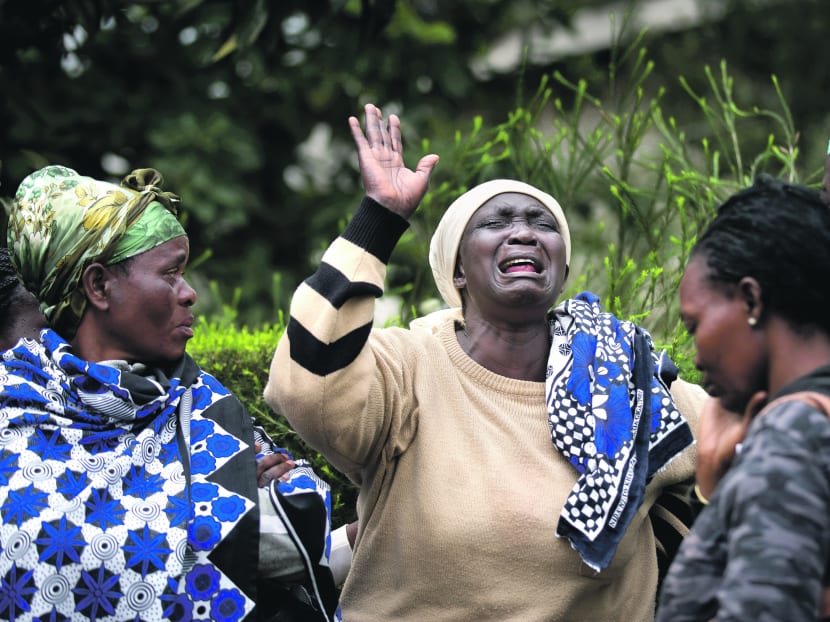Revenge, corruption behind Kenyan mall attack
NAIROBI (Kenya) — The plot was hatched weeks or months ago on Somali soil, by Al Shabab’s “external operations arm”, officials said. A team of English-speaking foreign fighters was carefully selected, along with a target: Nairobi’s gleaming Westgate mall.

Ms Mary Italo grieving at the Nairobi mortuary yesterday with relatives for her son, Thomas, who was killed in the Westgate mall attack. Photo: AP
NAIROBI (Kenya) — The plot was hatched weeks or months ago on Somali soil, by Al Shabab’s “external operations arm”, officials said. A team of English-speaking foreign fighters was carefully selected, along with a target: Nairobi’s gleaming Westgate mall.
The building’s blueprints were studied, down to the ventilation ducts. The attack was rehearsed and the team despatched, slipping undetected through Kenya’s porous borders, often patrolled by underpaid — and deeply corrupt — border guards.
A day or two before the attack, powerful belt-fed machine guns were secretly stashed in a shop in the mall with the help of a colluding employee, officials said.
That is the picture emerging from American security officials of the massacre at the mall, which killed scores of people over the weekend.
After a four-day stand-off, President Uhuru Kenyatta of Kenya claimed on Tuesday to have finally “ashamed and defeated our attackers”, declaring that the last militants still holed up inside the mall had been killed, though the bodies of many civilians, perhaps dozens, have yet to be recovered.
He added that “intelligence reports had suggested that a British woman and two or three American citizens may have been involved”, but that he could not confirm those reports.
United States officials said they had not determined the identities of the attackers and were awaiting DNA tests and footage from the mall’s security cameras, but that they did know the massacre had been meticulously planned to draw “maximum exposure”.
Kenya entered an official three-day period of mourning yesterday to mark one of the most unsettling episodes in its recent history.
The authorities, in a country widely perceived as an oasis of peace and prosperity in a troubled region, are struggling to answer how 10 to 15 Islamist extremists could lay siege to a shopping mall, killing more than 60 civilians with military-grade weaponry, then hold off security forces for days.
On multiple occasions, the government said the mall was under its control, only to have fighting burst out again.
The militant group has used Twitter to say that Somalis have been suffering at the hands of Kenyan military operations in Kenya, and the mall attack was revenge.
Yesterday, it claimed Kenyan government forces used explosives in carrying out “a demolition” of the building, burying 137 hostages. In a tweet from an account believed to be genuine, it also claimed that “having failed to defeat the mujahideen inside the mall, the Kenyan govt (sic) disseminated chemical gases to end the siege”.
Government spokesman Manoah Esipisu said no chemical weapons were used and that the collapse of floors in the mall was caused by a fire set by the terrorists.
Western security officials fear that several fighters slipped out of the mall during the mayhem of the attack, dropping their guns and disguising themselves as civilians, an account echoed by some witnesses.
The way the attack was carried out may have had something to do with the recent killing of Omar Hammami, an Al Shabab fighter who grew up in Alabama and became a phantom-like figure across the Somali deserts, known by his nom de guerre: Abu Mansoor Al Amriki, “the American”. He was fatally shot by another wing of Al Shabab less than two weeks ago.
One reason for the rift was Hammami’s complaints that the group had become too brutal towards fellow Muslims under the leadership of the group’s Emir, Ahmed Abdi Godane. That brutality, he said, was the reason Al Shabab had become so unpopular in Somalia and lost so much territory recently.
Mr Stig Jarle Hansen, a Norwegian researcher who has published a book on Al Shabab, said this rift might explain why the militants in the Nairobi mall decided to spare the lives of many Muslims.
Mr Aleem Manji, a Kenyan radio announcer, remembered that as he uttered an Islamic prayer to save his life, the gunman threatening to kill him also spoke fluent English. His accent was “light”, Mr Manji recalled, saying it definitely was not Kenyan.
US officials — who said they based their reconstruction of the plot on intelligence reports, witness statements and intercepted electronic messages — said the group may have recruited English speakers from the US and possibly other Western countries so that they would be able to operate effectively in Kenya, where English, along with Swahili, is the national language.
Some survivors, including a newspaper vendor who watched one militant mercilessly shoot a toddler in the legs, said other gunmen had been young and either Somali or Arab.
American officials said the militants must have had a back office in Kenya, a safe house to finalise their plot and store their guns. Witnesses said several militants had toted G3 assault rifles, a bulky weapon that Kenyan security services use.
Intelligence analysts said this may mean the militants acquired their weapons from corrupt Kenyan officers, who are known to sell or rent out their guns, charging as little as a few dollars an hour. Agencies






